Aicraft wiring
Some thoughts about how we intend to wire our aircraft
The electric circuit is quite an important part of o modern aircraft. Equipment gets more and more sophisticated and thus needs a quality power source. Today's aircraft usually have a simple electric circuit and a vacuum circuit for redundancy. The latter is heavy, cumbersome and failure prone. I think I will use electricity to power all the instruments. The goal is to remain a reliable as possible, I will use Boib Nuckoll's ideas. He is an aircraft electricity specialist. He has a web site: Aeroelectric.com and is answering questions on the Aeroelectric mailling list. The overall philosophy of the circuit is very simple, it is also modular. All the ideas need not be implemented at the beginning, this will allow spread the spending.
Today's circuits are generally based on the following drawing (the schematics are simplifies, only showing general principles.
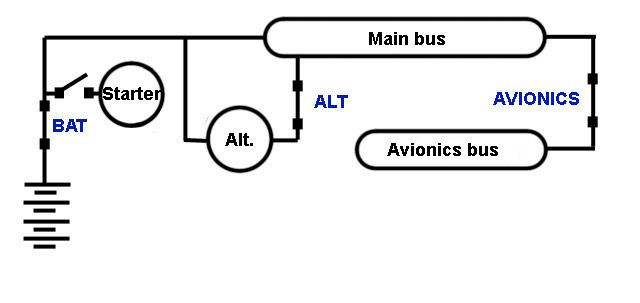
The alternator is powering the circuit when the engine is running, at the same time it reloads the battery that served for startup. The batttery is also used as a backup in case of alternator failure as shown in the following drawing.
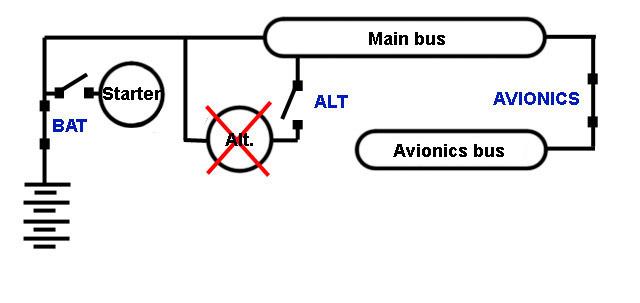
It may be noted that in this type of circuit all the avionics are powered from the avionics bus via the AVIONICS switch. In back-up mode, all the aicraft is powered by the battery as long as it will last. The alternator failure check-list should include load shedding to ensure the battery works as long as possible.
On our aircraft we will be using the following circuit:
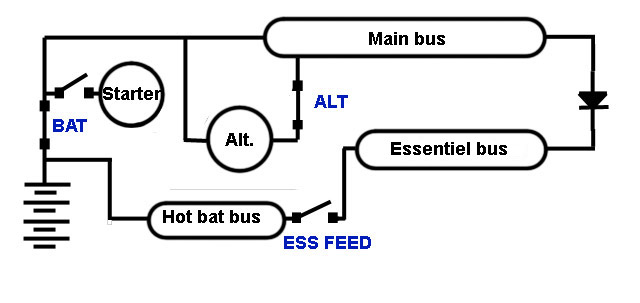
Following changes may be noted :
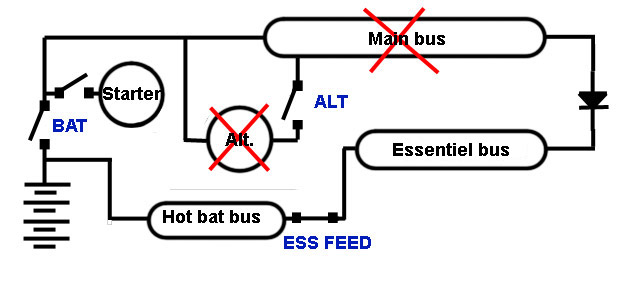
The pilot only does:
Open the alternator switch - Close the ESS FEED switch - Open the BAT switch.
The battery will the only power the Hot Bat Bus and the Essentiel Bus. These two buses only power the most needed instruments to bring the aircraft sfely back to the ground. As the Main Bus with it's big loads is no more powered, the battery will last longer. The pilot has not to evaluate which loads to shed, the evaluation is made during the circuit's conception. In case of alternator failure, the pilot flies the aircraft and does only this.
One possible enhancement to the circuit is to add a back-up alternator. Mounted on the vacuum pad, the alternator (in fact a generator) is only used in case of main alternator failure. If the circuit is correctly designed it's even possible to continue the flight to destination. The generator powers the Hot Bat Bus and the Essentiel Bus without depleting the battery.
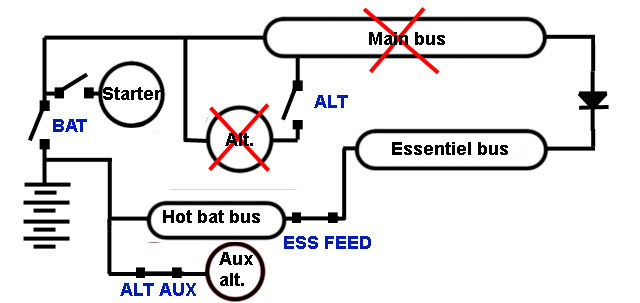
The electric circuit is quite an important part of o modern aircraft. Equipment gets more and more sophisticated and thus needs a quality power source. Today's aircraft usually have a simple electric circuit and a vacuum circuit for redundancy. The latter is heavy, cumbersome and failure prone. I think I will use electricity to power all the instruments. The goal is to remain a reliable as possible, I will use Boib Nuckoll's ideas. He is an aircraft electricity specialist. He has a web site: Aeroelectric.com and is answering questions on the Aeroelectric mailling list. The overall philosophy of the circuit is very simple, it is also modular. All the ideas need not be implemented at the beginning, this will allow spread the spending.
Today's circuits are generally based on the following drawing (the schematics are simplifies, only showing general principles.

The alternator is powering the circuit when the engine is running, at the same time it reloads the battery that served for startup. The batttery is also used as a backup in case of alternator failure as shown in the following drawing.

It may be noted that in this type of circuit all the avionics are powered from the avionics bus via the AVIONICS switch. In back-up mode, all the aicraft is powered by the battery as long as it will last. The alternator failure check-list should include load shedding to ensure the battery works as long as possible.
On our aircraft we will be using the following circuit:

Following changes may be noted :
- The AVIONICS switch is replaced by a diode that allows only current flow from the Main BUs to the Essential Bus.
- The Avionics Bus is replaced bey the Essentiel Bus and is normally powered by the Main Bus.
- A always Hot Battery Bus is created
- An ESS FEED switch is added, it allows to power the Essentiel Bus via an alternate path.

The pilot only does:
Open the alternator switch - Close the ESS FEED switch - Open the BAT switch.
The battery will the only power the Hot Bat Bus and the Essentiel Bus. These two buses only power the most needed instruments to bring the aircraft sfely back to the ground. As the Main Bus with it's big loads is no more powered, the battery will last longer. The pilot has not to evaluate which loads to shed, the evaluation is made during the circuit's conception. In case of alternator failure, the pilot flies the aircraft and does only this.
One possible enhancement to the circuit is to add a back-up alternator. Mounted on the vacuum pad, the alternator (in fact a generator) is only used in case of main alternator failure. If the circuit is correctly designed it's even possible to continue the flight to destination. The generator powers the Hot Bat Bus and the Essentiel Bus without depleting the battery.

| Naviguer à travers les articles | |
 Construction processes
Construction processes
|
Engine

|
|
|








